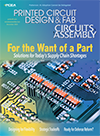Products
The DSP-1008 fully automatic screen printer comes with 2-D print inspection and analysis. Maximum conveyor speed is 1,500 mm/sec.; print speed is six to 200 mm/sec. Repeat positioning accuracy is reportedly +/-0.01 mm, printing accuracy is +/-0.025 mm. Cycle time is said to be less than 10 sec. Handles screens of 400 x 500 to 737 x 737 mm, and PCBs of 50 x 50 to 400 x 340 mm.
Shenzhen Desen Precision Machine Co., www.desen-sz.com
EA-6800 microelectronic adhesives for flip-chip semiconductor packages are said to offer two-fold improvement in cure rate; EA- 6900 is specifically formulated for the high temperatures that Pb-free assemblies must endure during rework. Are RoHS compliant. Cure in about 15 min., reportedly with no loss of performance. Come in production quantities. Feature reduced voiding from residual moisture within substrates and maintain a low modulus.
Dow Corning Corp., http://www.dowcorning.com/electronics
The DXH-3 hand-held dispenser weighs 5.3 lbs., with a 25 ml. max. output per stroke. Said to be ideal for dispensing in tight spaces and handling small-size applications. Dispenses a wide variety of ratios for two-component reactive resins. Can be refilled with a single DXR refill station. The refill station utilizes two transfer pumps that feed from 5-gal. bulk containers of material.
Mixpac Equipment Inc., www.mixpacequipment.com
AUTOset software subsystem incorporates KIC Vision auto-profiling and generates a preliminary reflow profile based on a PCB assembly’s physical characteristics. Also fine-tunes preliminary recipes to optimize the profile. Is installed in all new XPM3 Series reflow-soldering machines. Identifies suitable oven recipe prior to running a single profile.
Vitronics Soltec, www.vitronics-soltec.com
A family of SPDIP mating pin headers complements a line of SPDIP sockets. Shrink plastic packaging is said to reduce device lead spacing between pins down to 0.070" pitch. Used in memory, microcontrollers, video controllers and automotive design applications. For interconnect applications such as board stacking, socket testing and elevating circuits off the board surface. Precision-machined using brass alloy 360 and configured with pluggable tails.
Mill-Max, www.mill-max.com
Mill-Max, www.mill-max.com
Flashstream flash programmer currently supports more than 160 device part numbers from Samsung, Intel, Spansion, ST Micro, Hynix, SST and Atmel. Comes in two models: 3000FS contains four programming sites, is rated at 1050 devices per hour, and handles parts in tray, tube or tape for device input or output. HelixFS is rated at 800 cph. Current universal site supports more than 25,000 device part numbers.
BPM Microsystems, www.bpmicro.com
BPM Microsystems, www.bpmicro.com
The MT-300 Pb-free dual wave solder system is available for low- to mid-volume, defect-free soldering of high-density boards populated with through-hole, surface-mount, or mixed technology components. Small footprint (8' long); uses dual transducer-controlled motors for uniform wave heights; features an adjustable titanium finger conveyor with a max. board width of 11.75". Automatic finger cleaner is standard, as are titanium-alloy solder pot, wave nozzles, and heavy-duty pumping system. Pot capacity of less than 500 lbs.
Manncorp, www.manncorp.com
The online interactive Alpha Wave Solder Flux Selector tool is designed to assist assemblers in identifying the best Alpha flux for their application. Said to meet the challenges of Pb-free and SnPb processes. Reportedly offers environmental and worker safety benefits while providing soldering and reliability performance. Can be found at http://www.alphametals.com/showCookWSFCalc.asp.
Cookson Electronics, www.cooksonelectronics.com
eTEC is a thin film embedded thermoelectric cooler that addresses thermal management needs. Functions as a miniature, solid-state heat pump. Is ideal for cooling hot spots that result from localized areas of high heat flux on an IC. Is manufactured using semiconductor processing techniques. Said to maximize current flow and minimize heat flowing back from the hot side to the cold side of the IC. Adds 100 µm of height to a heat spreader. Reportedly has a millisecond response time to maintain precise temperature. Pumps a max. heat flux of 150 W/cm2, with some designs delivering as much as 400 W/cm2.
Nextreme, www.nextreme.com
Self-Saturating Foam Swabs quickly and cleanly remove contaminants from hard-to-reach electronics components, magnetic heads and other areas where high-reliability cleaning is required. Contain IPA/DI fluid, consisting of 91% isopropyl alcohol and 9% deionized water. Handle is manufactured from clear polypropylene; the swab tip is comprised of 100 PPI foam. Solvent and applicator combined in one unit. Is a non-aggressive cleaner, suitable for use on plastic or metal surfaces. High evaporation rate. Each swab is filled with 1.4 ml of IPA/DI; tip is 100 PPI Foam, is 27 mm in length and is 14.25 mm wide. Available in packs of 50. Boiling point is 82-83°C and flash point is 12°C.
QTEK Manufacturing Ltd., www.qtek.com
The Ultra-Cure UV Curing Module offers topside curing of UV-curable conformal coatings and other UV-curable materials. Uses a modular design to deliver consistent curing of various width substrates up to 18". Is equipped with Fusion UV Systems Model F300 SQ lamps and is designed to accommodate up to three 6" lamps. Uses a PLC-based control system with an operator interface terminal for setup and alerting.
Ultrasonic Systems Inc., www.ultraspray.com
The BVX-200 Fume Extraction System with brushless motor technology is said to eliminate wear out of motor parts and increase system lifetime in normal operation. Is also said to deliver improved extraction performance and has a wider range of operating modes. Advantages include enhanced reliability, zero dust generation and increased motor efficiency. Electrical noise and RF interference are reduced, and sparking between brushes and commutator rings reportedly is eliminated. Is available in all systems and will not affect part numbers.
OK International, www.okinternational.com
Press Releases
- Altus Reports Growing Demand for Guidance on Convection Reflow Oven Specification
- Coherix Opens New Adhesive-Dispensing Vision Center in Europe
- Pan Pacific Strategic Electronics Symposium Program Finalized
- The Most Critical 2 Inches in SMT Manufacturing – When a Splice Fails, the Line Fails, Full Stop. Throughput and Yield Depend on One Overlooked Moment


